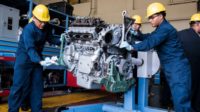The U.S. Environmental Protection Agency has proposed two new rules setting more ambitious vehicle emissions standards for passenger vehicles and trucks.
In announcing the proposal on April 12, officials said that, if implemented, the new regulations would avert about 10 billion tons of CO2 emissions, save owners $12,000 compared with costs of vehicles that do not adhere to the new proposed requirements and reduce U.S. use of about 20 billion gallons of imported oil.
For the construction industry, the main focus is a proposed rule setting new emissions limits for dump trucks and other heavy-duty vehicles.
The proposal does not apply to off-highway equipment.
The proposal constitutes "Phase 3" heavy-truck emissions standards. They follow Phase 2, which EPA made final last December.
The new standards would “set progressively more stringent GHG emission standards," measured in grams per ton-mile, the agency said, and would set new GHG emissions standards that would apply to vehicles from model years 2027 through 2032 and beyond.
Performance-Based Standards
As with the new light- and medium-duty vehicle proposal, the new one for heavy-duty trucks and engines uses performance-based standards that EPA said will “enable manufacturers to achieve compliance efficiently based on the composition of their fleets.”
It said the proposal does not mandate the use of specific technology and added that it anticipates fleets would use “a diverse range of technologies,” in components such as transmissions, engines and battery electric powertrains.
The agency said the proposed Phase 3 standards would improve air quality and is projected to avoid 1.8 billion tons of CO2 through 2055.
Along with the new model-year 2028 and beyond requirements, EPA also said it is revising some Phase 2 standards for the 2027 model year. For example, the agency is seeking to eliminate the last model year–2027–of advanced technology incentives for certain electric heavy-duty vehicles.
It also proposes to add warranty requirements for batteries and other components of zero-emission vehicles.
The deadline for comments on the two proposed rules is 30 days after they are published in the Federal Register.
Manufacturers: 'Monumental Opportunity'
Jed R. Mandel, president of the Truck and Engine Manufacturers Association, said in a statement that the Phase 3 regulation process "presents a monumental opportunity to further accelerate the transition of the nation's trucking fleet to zero-emission vehicles."
Mandel said in an April 12 statement that his association was still reviewing the EPA proposal but added that "EMA member companies already are producing heavy-duty ZEVs and want them deployed on the nation's roadways as soon as possible."
He added that it is "imperative" to have adequate infrastructure for electricity charging and hydrogen fueling.
Trucking Association Comments
Chris Spear, American Trucking Associations president and chief executive officer said in a statement that regarding emissions, "The trucking industry starts at ‘yes.’
Spear added, We share the goal of reducing greenhouse gas emissions and improving fuel efficiency and believe any regulation must be practical, achievable, and based on sound science."
But Spear said ATA is "extremely disappointed" that EPA decided to make changes in the Phase 2 regulation, "which had been set for years."
EPA noted in the text of its proposed regulation that the transportation sector is the largest U.S. source of greenhouse gas emissions (GHG) emissions, accounting for 27% of the total.
EPA also says that heavy-duty vehicles are the second largest source of transportation sector GHG emissions, with 25% of the sector's total.
The agency added, “The potential for the application of zero-emission vehicle technologies in the heavy-duty sector presents an opportunity for significant reductions in heavy-duty GHG emissions over the long term."
It also said trucking fleets, heavy-duty vehicle and engine manufacturers and states have announced plans to boost the use of zero-emissions technologies in coming years.
In addition, EPA noted that the Infrastructure Investment and Jobs Act and the Inflation Reduction Act have “significant and unprecedented monetary incentives” for producing and buying zero-emission heavy duty truck vehicles.
Key Senators Weigh In
Among key federal lawmakers, Senate Environment and Public Works Committee Chair Tom Carper(D-Del.)saidthe two proposed regulations "would make significant progress in our fight against climate change. They will also save Americans money at the pump and better insulate our country. from the volatility of the global oil market."
But the committee's top Republican, Sen. Shelley Moore Capito (W.Va.), calledthe proposals "misguided" and said that they "were made without considering the supply chain challenges American automakers are still facing, the lack of sufficiently operational electric vehicle charging infrastructure or the fact that it takes nearly a decade to permit a mine to extract the minerals needed to make electric vehicles, forcing business to look to China for these raw materials."
Capito also noted that an electric vehicle's average price in 2022 was about $65,000, which exceeded the household income of 46% of U.S. households.




Post a comment to this article
Report Abusive Comment